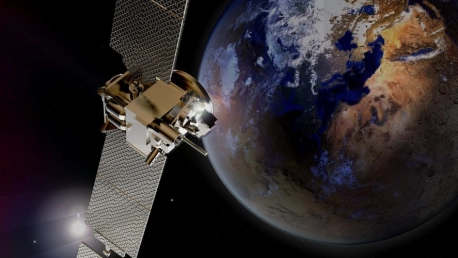As the world’s richest man, it’s not surprising that Elon Musk has a lot on the go. Between recalls at Tesla, the launch of his Cybertruck, and navigating complaints at Neuralink, the billionaire founder has had plenty on his plate. But that hasn’t stopped him from pushing the envelope over at Starlink. The company has already made waves for its ambitious satellite network, which operates in over 70 countries. In furthering Starlink’s influence and reach, the company has announced a first of its kind direct-to-cell service offering.
Direct-to-Cell Launch
Starlink kicked off 2024 with the launch of the first 6 of 21 direct-to-cell satellites; their objective is to act as cellphone towers in space. Naturally, the benefit of being a Musk-owned business is the ability to partner with sister organizations, and SpaceX has been instrumental to the success of Starlink’s satellite manufacturing and launches, and delivered once again on the direct-to-cell project. SpaceX’s experience in rocket and satellite launches means the company is uniquely positioned to coordinate the Starlink direct-to-cell satellite deployment, making use of the Falcon 9 spacecrafts for the initial launches, followed by Starship. The innovation in direct-to-cell technology is that connectivity is provided directly from the orbiting satellite to mobile devices, without any additional on the ground infrastructure. While this is nothing short of extraordinary, Musk tempered expectations with the warning that this solution is not a competitor to terrestrial networks. Direct-to-cell’s main aim is to provide connectivity to remote areas, where signal is difficult to deliver. In technical terms, 4G LTE-compatible, unmodified devices will be able to connect with these new satellites. This description, according to T-Mobile, covers the majority of the cell phones on its network. We can also expect to see a text messaging service released later this year using the same technology, with voice, data, and IoT services becoming available in 2025. Their expansion plan will mimic the T-Mobile partnership, with similar setups globally. So far, they’ve solidified commitments with Optus in Australia, Rogers in Canada, One NZ in New Zealand, KDDI in Japan, Salt in Switzerland, and Entel in Chile and Peru.
The Technology Behind Direct-to-Cell
The satellites feature an advanced eNodeB modem. It manages radio interface for cells, as well as procedures for establishing a radio link. Once in orbit, the modems connect via laser backhaul to the Starlink low Earth orbit (LEO) constellation. The Starlink satellites, with eNodeB modems onboard, then beam internet connectivity to smartphones, globally. Essentially, the eNodeB modem is the specific component that acts as an intergalactic cell tower.
Approval for Direct-to-Cell
Attaining approval from the US communications regulatory body, the Federal Communications Commission (FCC), was a huge milestone for this project. Starlink submitted an application to the FCC to prove their case of “supplemental coverage from space for consumers on a permanent basis”. In partnership with SpaceX, the company was granted 180 days to complete the tests, which they estimated would require 840 satellites carrying direct-to-cell payloads, of which 60 would be providing connectivity to mobile phones base in the US. The trials will be carried out over the 1910-1915MHz and 1990-1995MHz frequencies, more commonly referred to as the PCS G-Block. This approval comes on the heels of the FCC announcement of partial authorization that was granted for SpaceX to launch and operate their Gen2 broadband satellites. According to the FCC, this would enable the Musk-owned enterprise to fulfill its mission of bringing internet connectivity to Americans across the country, while protecting other terrestrial and satellite service providers from interference, maintaining a diplomatic and safe space environment.
The Competitor Response
It’s not hard to imagine that Starlink’s continued growth in the satellite networking industry has ruffled feathers. Mobile network competitor AT&T voiced their concern through a petition lodged against Starlink, claiming their direct-to-cell solution could disrupt other frequency blocks and interfere with terrestrial services. According to Bill Ray, VP Analyst at Gartner, Starlink poses a genuine risk, given their antennas are significantly smaller when compared to rivals such as AST Spacemobile. The larger antenna, he noted, “makes it capable of putting down a small spot beam, which limits interference.” He further noted that Starlink’s smaller antenna “means bigger spot footprints and more potential interference.” The FCC, however, affirmed Starlink’s ambitions and agrees they deserve the chance to test their theory. What the FCC don’t agree with, is that the project is worth an $885 million subsidy from the Rural Digital Opportunity Fund.
Starlink vs Project Kuiper, Battle of the Stars
The unspoken, well documented rivalry between billionaires Elon Musk and Jeff Bezos has spilled over in to a space race. Blue Origin versus SpaceX, and Starlink versus Project Kuiper. In a move that seemingly affirms both SpaceX and Starlink’s lead in the race, Amazon is in the process of singing a contract with SpaceX, leveraging the company’s expertise to deploy Project Kuiper satellites. Amazon has asserted that their seeking of support from SpaceX is in an effort to scale their launch schedule, but critics have their doubts, given a number of their procured service providers have yet to take their maiden flight. SpaceX was initially left off the consideration list when Amazon onboarded satellite launch partners, with reports stating this led to a shareholder filing a lawsuit against the company alleging a lack of due diligence in the awarding of contracts. The plaintiff insinuated in the suit that the hostile relations between Bezos and Musk is at the heart of SpaceX being overlooked as a service provider, despite being leaders in satellite deployment and offering cheaper rates. Amazon’s Project Kuiper has surpassed its first major milestone, having tested two satellites in space, delivering an outstanding 100% success rate on its maiden mission. To challenge Starlink’s domination in the satellite network industry, Project Kuiper will have to, in some capacity, rely on their rivals, to get their satellites into orbit. It’s an uneasy position for anyone to be in, but given the history between Bezos and Musk, it’s likely a giant rocket-shaped pill to swallow.
Conclusion
Increasingly, the access to internet connectivity is being considered a basic human right. With direct-to-cell satellite communication, Starlink is taking a step toward a future where this is possible. Acting as a cell tower from space, direct-to-cell will provide broadband access to rural communities, but will not be a meaningful competitor to terrestrial network providers. While Starlink will be thrilled to continue expanding its space satellite constellation, FCC approval for testing sent many tongues wagging with complaints the infrastructure could cause interference. With mobile partner T-Mobile, Starlink is set to soon conduct trials with 60 mobile users across America, which should either allay or confirm the concerns of competitor companies. With a slew of commitments from other mobile carriers in countries around the world, 2024 is set to be an interesting year for Starlink.









